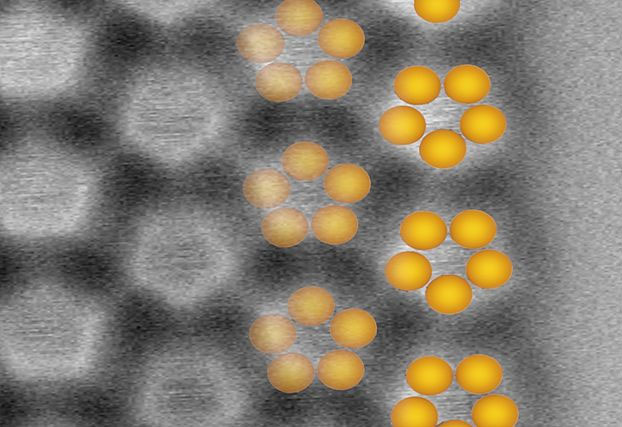| Aug 08, 2024 |
2D layer of phosphorus pentamers shows semiconductor properties on silver surface
(Nanowerk News) Phosphorus is an exciting element: It is essential for the survival of organisms and promises numerous electronic applications. With this in mind, researchers at the University of Basel have synthesized two-dimensional layers containing rings of five phosphorus atoms (phosphorus pentamers (cyclo-P5)) on a silver surface.
|
|
For the first time, they have been able to investigate their electronic properties using combined atomic force and scanning tunneling spectroscopy. They found that the atomic phosphorus pentamer layer retains its semiconductor properties and forms a special electronic interface where the layer joins the silver surface (p-type semiconductor-metal Schottky junction).
|
|
This shows that phosphorus pentamers on the silver surface fulfill a basic requirement for applications in field-effect transistors, diodes or solar cells, as recently reported by the research team in the scientific journal Nature Communications ("Probing charge redistribution at the interface of self-assembled cyclo-P5 pentamers on Ag(111)").
|
|
Phosphorus is a vital component of every organism and plays a key role, for example, in energy transfer in the body and within cell membranes, bones and teeth. Phosphorus is also special because it occurs in numerous different forms (allotropes).
|
|
For example, there is the highly explosive, toxic white phosphorus, the more stable red phosphorus known from match heads, or the crystalline, semi-conducting black phosphorus. The latter has numerous applications in electronic devices. The variety of phosphorus compounds and their physical and chemical properties can be further extended by the self-assembly of two-dimensional phosphorus structures on surfaces.
|
 |
| When two-dimensional layers containing rings of five phosphorus atoms (phosphorus pentamers) are formed on a sliver surface by self-assembly, the phosphorus layer retains its semiconductor properties and a special interface (a p-type semiconductor-metal Schottky junction) forms at the interface with the silver surface. (Image: R. Pawlak, Department of Physics, University of Basel)
|
Various two-dimensional layers
|
|
Researchers from the group led by Professor Ernst Meyer at the Department of Physics and the Swiss Nanoscience Institute at the University of Basel have now produced various two-dimensional phosphorus structures on silver surfaces by evaporating phosphorus atoms.
|
|
In addition to chains and hexagonal rings, they also produced planar rings of five phosphorus atoms (phosphorus pentamers), each of which behaves like an anion, i.e., is negatively charged. In order to assess whether such 2D layers consisting of phosphorus pentamers are suitable for applications in nanoelectronics and nanooptics, it is necessary to characterize the properties of the atomic layer and investigate the interactions with the metallic surface.
|
Meaningful data through a combination of methods
|
|
Using a combination of atomic force and scanning tunneling spectroscopy at low temperatures of 4 kelvin (-269.15 °C), the researchers found that the phosphorus pentamers retain their semiconducting properties on the silver surface.
|
|
“This distinguishes the phosphorus layer from a hexagonal graphene layer, for example, which is metallic when in direct contact with a metallic surface,” explains Dr. Rémy Pawlak, who supervised the experiments.
|
|
The phosphorus pentamer layer causes electrons to pass from the metal into the phosphorus layer and a special boundary layer, known as a p-type semiconductor-metal Schottky junction, is formed. “The formation of a Schottky junction at the interface could enable applications in field-effect transistors, in solar cells or as diodes,” adds Professor Ernst Meyer.
|
|
The results were confirmed by simulations carried out by research groups from Shenzhen and Shanghai in China.
|

